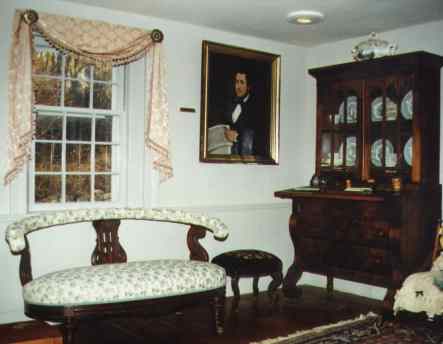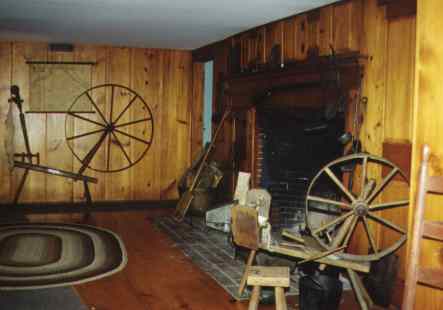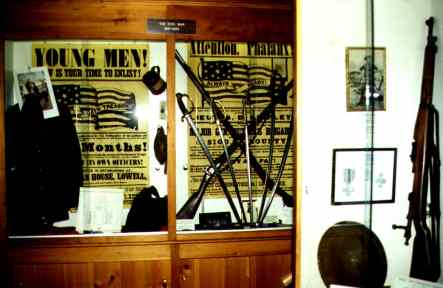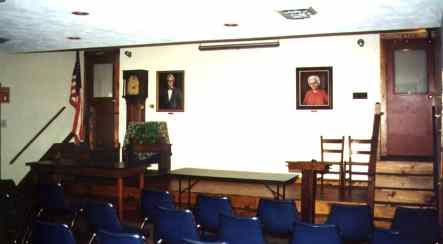
The Front Parlor
- Horsehair sofa - bas been restored
- Mural- Copp's Hill and Breed's Hill in Boston
- Jar on table - after an explosion of a powder mill in Lowell in 1903; the pieces were glued together to make the jar
- Byam table and the Banjo clock above
- On the desk of Susan McFarland's secretary is a parallel ruler, seal, sander to dry the ink and old-fashioned ink well
- Mrs. Otis Brown's chair and doll
- Foot warmer by the fireplace
- Flax wheel
- Bed warmer
- Hair wreath- the Lord sisters made it in memory of their sister, Emma, who died in 1903. Ladies saved the combings of their hair to make into pm,, bracelets, funeral wreaths and wooding wreaths.
- China in cabinet- owned by William Fulton, a former president of the society. - notice the cups without handles
- Front Hall - central chimney for 5 fireplaces - people could hide under the stairs

The Keeping Room
- It was probably the original home with birthing room at one end. There was probably a loft above where the children slept
- Chest with "T B. 1709" for Thomas Barrett made by a member of his family
- Bible box given to society by Dick and Mary Lahue. Family records were kept in the family Bible
- Tin ware - oil can with a handle and a side spout was used to fill the oil lamps in The center of town, a black and silver tin with an opening in the front to light a wick had a removable cover and the little pan inside was used to warm milk for a baby. There is also a sausage stuffer and a split horseshoe for the cleft hooves of an ox. (It was found on the property) There is also an apple parer and corer
- There is a large spinning wheel for spinning wool and a small one for flax
- On the floor is a clock wheel for winding yam. The wheel clicked twenty times and the girls would sing, "Pop Goes the Weasel" as it went around
- Linen and flax were grown in the fields, cut with a sickle; bound in bundles; soaked in a brook or pond (retted), scutched (beaten), hatcheled (cleaned with an ugly toothed-tool), and spun on the wheel in the parlor. Next to the fireplace in the keeping room is a quilling wheel for winding yarn on a bobbin to go in a shuttle for weaving. (A goose quill was the first bobbin; it is hollow and fit on the spindle)
- On the table is a niddy-noddy. It is the long wooden piece with what looks like a handle in each end but going cross-wise. This is a skein winder and they wound the skeins by making a figure eight. The girls would chant "ruddy-noddy, niddynoddy, two heads and one body"
- The large ball on the table hung at the stagecoach stop by Reed's Tavern in the Center located where the Old Town Hall is now. The ball was on a long arm that could be lowered or raised. If it was down, there were passengers waiting, but if it was up they "high-balled" through town without stopping. Today, the expression is used when politicians ''high-ball" on their election trails.
- Woodenware - trunnels (tree nails) lemon squeezer, bowl from burl, Dr. Marshall's ruffle crimper, churns, etc
- The large fireplace was used for cooking, heat, and light
- Iron - cooking equipment made by blacksmith - crane, S-hooks, trammel boom, soup kettle, Dutch oven, toaster, all use direct or radiant heat
- The Beehive Oven uses stored heat for baking. The fire was buit in the oven and when the oven was hot the ashes were removed with the iron peel and put in the bottom under the baking chamber. The bread was then baked in the oven and then removed with the wooden peel There are S-hooks and trammel hooks on cranes to hang the pots on for cooking
- The fireplace bas a rifle hung over it. A gun was always kept handy in case of an attack. The pewter plate on the mantel has a chunk out of it. During the Revolutionary War, lead for bullets was scarce so people cut up their pewter and mehed it down to be used for bullets. Pewter is mostly made of lead which is the reason that there is very little pewter left from that period

The Children's Room
- There are pineapple posts on the feather bed and a trundle bed underneath.
- The Betsy Bobbet doll on the highchair belonged to Hazel Stevens. "Miss Flaked Rice" is written on her stomach. The bags of rice bags came with an advertisement on the front and a pattern for a doll. The mother would cut it out, sew it together, stuff it and a little girl had a rag doll.
- The high chair belonged to President Franklin Pierce
- The dollhouse belonged to the Fisk family
- On the mantel of the fireplace are little chairs, made in those days by the fathers with little sticks of wood from trees. One chair took 16 pieces
- The roller skate is similar to our in-line skates of today, but only one was used, similar to a scooter
- Noah's ark in the glass case was all hand carved. It came from England and over 100 years old.

The Military Room
- The Military Room is dedicated to Donald Fogg who was a CHS teacher. He lost his life in action in North Africa during WWII. His uniform is hanging in the Memorial Room. His wife Julia was the curator for many years
- The room is dedicated to all Chelmsford residents who fought in all wars from the Revolutionary War through the Vietnam War
- The Civil War sword was made by C. Roby and Company in West Chelmsford. The company originally made scythes that were sold to the south. The company changed to producing swords for the North during the Civil War. The name Roby is on the bJade just below the hilt
- Powder horns were usually made from oxen horns

The Watt-Stevens Meeting Hall and Exhibit Area
- The Byam Bedroom - Victorian furniture of the 1880's. Pictures of Josiah and Thankful Byam, chamber pot on the floor to use during the night
- Baby's Room - old crib; wicker equipment; clothes
- Kitchen- wooden agitator washing machine used in the brook, later in time clothes were boiled in oblong metal cans on a wood stove and the wood fork was used to slosh them around. Also a hand powered vacuum cleaner, cooking equipment, sewing machine, scrubbing boards, sewing machine, popover pan, apple corer on the front of the table, butter churn on rear of table, and the base to an old iron. Old irons had two bases so that one could be heating on the fireplace while the other was being used. Wood piece on floor with a notch in it is a boot remover. The icebox with tongs was used in the 1930's. Ice was delivered to the house by wagons and later trucks. The size block needed was indicated by a card in the window of the house, which was printed with .25, .50 etc. depending on the size wanted. The water tray in these iceboxes had to be emptied daily
- Parlor - Edison record player, records, marble top table, hair wreath on the wall, lap organ on the floor
- Schoolroom - The blackboard is from the South Chelmsford Schooi the desk and chair was used by Ralph Waldo Emerson while teaching at Chelmsford Academy (where the Baptist Parsonage is now). This is how Academy Street was named. The stove (with lunch pail on it) belonged to Susan Mcfarlin, a former teacher who used it when she first taught in a one-room schoolhouse in East Chelmsford. The Mcfarlin Schooi now Mcfarlin Manor, was named for her
- Doctors' Exhibit. Dr. Scoboria's dental chair, dental tools, and a tooth extractor
- Town Hall - ballot box, pictures, bench. The boxes on the floor were used as spit boxes for those who chewed tobacco
- Books from the Social Library which was the first library in town
- Pictures of Charles Watt and Hazel Stevens are on the stage. Richard and Claire Norton gave the grandfather clock to the society
- Tool exhibit in the hallway: Cheese Press - Cheese was made in a table with a tin top and five or six inches dep. Milk was boiled in it, left to sour then drained and put into a cheese press; iron nails (wood nails were called tree nails or ''trunnels"; cranberry collector is a wooden toothed piece; jack used for changing wheels on carts or wagons. Most of the other tools are recognizable.
- Native American articles: Oblong basket was made by Native Americans for Dr. Marshall to take his medicines in. The stones on the bottom shelf are pestles used to pound meal, corn, etc.

The Country Store
- Meeting place of people in every town
- Place to buy almost everything they needed
- Place to collect their mail
- Post Office from South Chelmsford was established on May 29, 1870 and donated to the society by Mabel Paignon
- Crocks and barrels were for pickles, molasses, sugar, etc
- The woodstove came from Helen Poland's father
- The windlass (pulley) in the middle was for hauling things to and from the cellar such as barrels of molasses, sugar, flour, and animal feed. The windlass came from Parkhurst's store where Henry Ericson's store was originally located at "Chicken Corner'' in the center of the town
- Hanging from the ceiling: round tin bath tub; ladies skirt hoop; basket for a baby bed